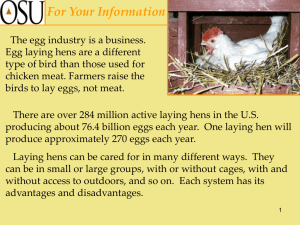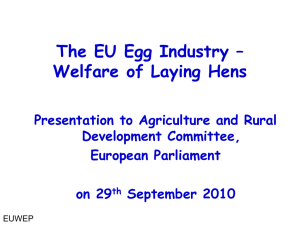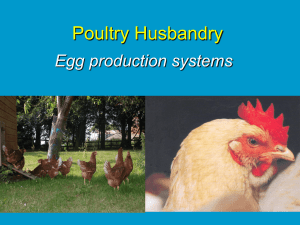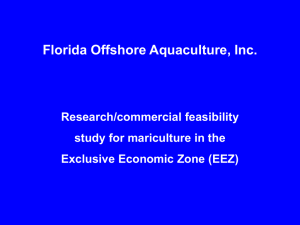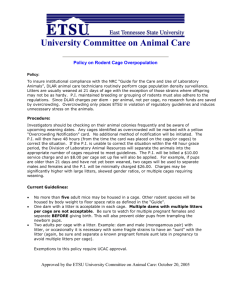production in europe and germany
advertisement
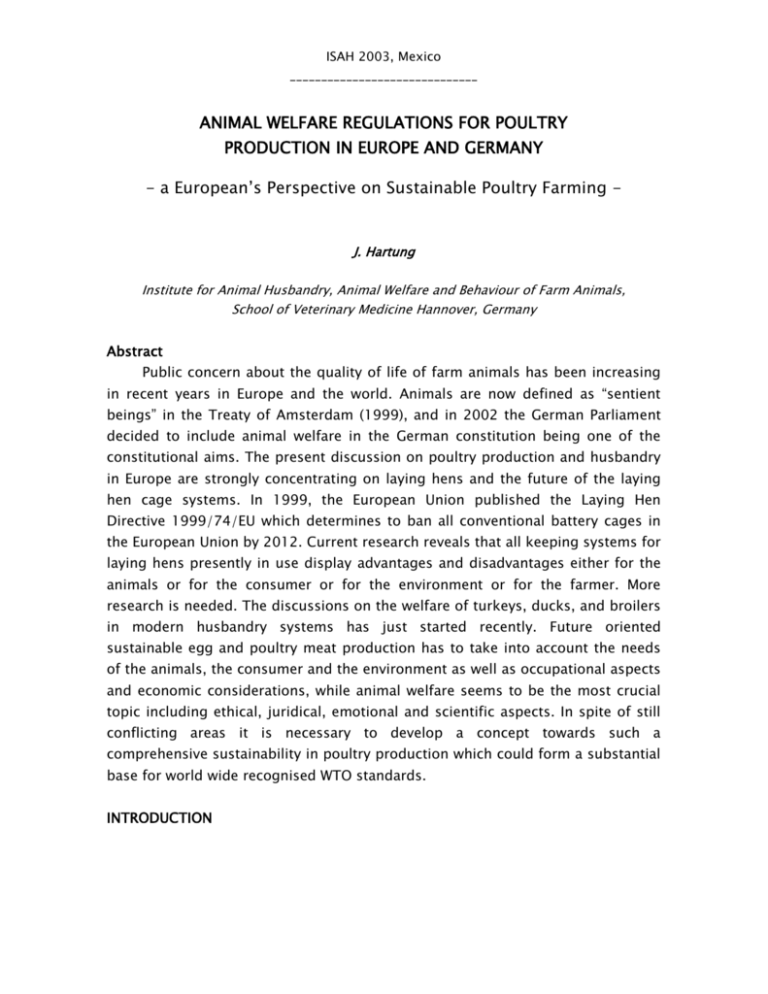
ISAH 2003, Mexico ______________________________ ANIMAL WELFARE REGULATIONS FOR POULTRY PRODUCTION IN EUROPE AND GERMANY - a European’s Perspective on Sustainable Poultry Farming - J. Hartung Institute for Animal Husbandry, Animal Welfare and Behaviour of Farm Animals, School of Veterinary Medicine Hannover, Germany Abstract Public concern about the quality of life of farm animals has been increasing in recent years in Europe and the world. Animals are now defined as “sentient beings” in the Treaty of Amsterdam (1999), and in 2002 the German Parliament decided to include animal welfare in the German constitution being one of the constitutional aims. The present discussion on poultry production and husbandry in Europe are strongly concentrating on laying hens and the future of the laying hen cage systems. In 1999, the European Union published the Laying Hen Directive 1999/74/EU which determines to ban all conventional battery cages in the European Union by 2012. Current research reveals that all keeping systems for laying hens presently in use display advantages and disadvantages either for the animals or for the consumer or for the environment or for the farmer. More research is needed. The discussions on the welfare of turkeys, ducks, and broilers in modern husbandry systems has just started recently. Future oriented sustainable egg and poultry meat production has to take into account the needs of the animals, the consumer and the environment as well as occupational aspects and economic considerations, while animal welfare seems to be the most crucial topic including ethical, juridical, emotional and scientific aspects. In spite of still conflicting areas it is necessary to develop a concept towards such a comprehensive sustainability in poultry production which could form a substantial base for world wide recognised WTO standards. INTRODUCTION ISAH 2003, Mexico ______________________________ Challenges for poultry management in the future are widely seen in the following areas: 1. Satisfactory supplies of eggs and meat for a growing world population 2. Cost efficiency of production (economy) 3. Product safety, diversity and quality (consumer protection, perception, acceptance) 4. Low indoor and environmental pollution (ecology) 5. Husbandry systems in line with animal needs (animal welfare) (Animal friendly housing and handling) Particularly animal welfare gained more and more attention in the last decade. In the document of Maastricht (1992) animal welfare was first mentioned in a highly ranked document saying: The conference asks the European Parliament, the Council and the Commission as well as the member states to safeguard the welfare of animals whenever legal regulations are worked out for agriculture, traffic (transport) affairs, the common market or scientific research. Since then public concern about the quality of life of animals has significantly increased. Animals are today defined as “sentient beings” in the European Treaty of Amsterdam (1999), and in 2002 the German Parliament decided to include animal welfare in the German constitution being one of the constitutional aims. Nevertheless the definition of animal welfare is still under consideration. One of the problems is the definition of limits or thresholds. When does good welfare conditions end and when does suffering starts? What is still acceptable for an animal and when are the limits of adaptation exceeded? The problem is that these limits are fluid and depend on the individuals experience and ability to cope with situations. Who can monitor and control the individual in a battery cage or a flock of 40,000 broiler birds? Herd health which is sometimes called a sufficient welfare indicator cannot take into account the needs of the individual bird, and suffering or pain is always a individual feeling and experience. Therefore all definitions of welfare are related to the individual animal. Three examples of definitions are given below: The state of well being is achieved, when an animal lives in harmony with itself and the environment (after Hughes, 1976). Animal welfare is based substantially on an undisturbed, species specific and ethologically adequate life situation (German Animal Protection Act, 1985).The welfare of an individual is its state as regards its attempts to cope with its ISAH 2003, Mexico ______________________________ environment (Broom, 1986). This latter definition is widely used today and means that the welfare of an animal is not impaired as long as it is able to take actively or passively advantage of the environment, avoid longer lasting frustrations and reaches some individual form of harmony with the environmental conditions. LEGAL SITUATION FOR LAYING HENS The present discussions on poultry production and husbandry in Europe are strongly concentrating on laying hens and the future of the laying hen cage systems. The year 1999 marked a turning point in the history and development of egg production in Germany and Europe. On July 6th, 1999 the German Supreme Court which deals with constitutional matters declared the national regulation for the keeping of laying hens in battery cages null and void because it violates the animal welfare act: The animals are not given sufficient space in the barren environment of the cages and they are unable to display normal behaviour. Seven days later, on July 13th, 1999, the European Union published the Laying Hen Directive 1999/74/EU which determines to ban all conventional battery cages in the European Union by 2012. The Directive gives details on management, housing and equipment in the alternative systems and in the cage systems as well as an itinerary for phasing out the conventional batteries for laying hens. The most important facts and data of the Directive are given in brief: Conventional Cages Cages with less than 550 cm² per hen are banned from January 1st, 2003. This is usually achieved by lowering the animal density in the cages by removing one bird per cage. Feeder length at least 10 cm per hen 2 nipple drinkers in each cage Height above 65 % of the cage floor area more than 40 cm, not less than 35 cm Slope of cage floor less than 14 % (8°) Abrasive materials for trimming the bird`s claws, usually placed in form of stripes directly in front of the trough that the claws are trimmed during feeding. ISAH 2003, Mexico ______________________________ Conventional cages are phasing out by December 31st, 2011. ISAH 2003, Mexico ______________________________ Enriched Cages From January 1st, 2012 enriched cages are allowed, only. The criteria for enriched cages are: 750 cm² cage area per hen, 600 cm² usable, minimum 2000 cm² per cage Height other than above usable area at least 20 cm A separate laying nest with reduced light litter for scratching or a sand/dust bath perches for all hens (at least 15 cm per bird) Feeder length at least 12 cm per bird An appropriate number of drinkers, two nipple or cup drinkers in reach Width of the aisle in the animal house between the blocks of cages at least 90 cm, Floor to bottom height in the cage at least 35 cm Claw trimming devices In the recent German regulation on the protection of farm animals, part requirements for laying hens, (October 25th, 2001) a height of 200 cm for each single cage is required which will make it practically impossible to install several tiers of that height in an animal house. Alternative Systems The most important criteria for the so called alternative systems which allow the hens more freedom and natural behaviour are: The following requirements apply to all such systems built, rebuilt or restarted production after January 1st, 2002 From January 1st, 2007 the requirements apply to all alternative systems Feeder length must allow at least 10 cm per bird, round troughs at least 4 cm per bird Drinker must provide at least 2.5 cm/bird, round troughs at least 1 cm per hen. When drinking water is supplied by nipple drinkers, one nipple serves not more than 10 hens. One individual nest for 7 hens, one m² nest area for 120 hens in case of group nesting Place on perches at least 15 cm per hen, not above littered area ISAH 2003, Mexico ______________________________ Distance between perches at least 30 cm, distance to walls not less than 20 cm 250 cm² littered area per hen or at least one third of floor area Maximum of 4 levels in aviaries Headroom between levels 45 cm Equal access to feeders and drinkers for all hens Access to open runs, popholes 40 cm wide, 35 cm high, A total opening of 2 m per group of 1000 hens Maximum stocking density 9 hens per m² usable area indoors In open runs appropriate area best with grass should be available, shelter from weather (rain, sun) and predators WHAT WAS THE BACKGROUND OF THE NEW DIRECTIVE? Not all of the figures and measures are based on scientific knowledge either because of lacking data or because of non conclusive experimental results. However, for a legal regulation clear advice is essential. In order to understand the full picture it seems useful to focus on some developments in animal production in the last few decades which have influenced the facts and feelings which are behind political and juridical decisions with considerable consequences for the industry, the farmers, the consumer, the environment and the animals. 1. DEVELOPMENT OF EGG AND BROILER PRODUCTION DURING THE LAST FEW DECADES The first cages for laying hens were used in 1924 in the United States. In Europe sixty years ago egg production was a typical “by-product” on family farms. Cages for laying hens were widely introduced after the 2nd World War, only, ending the area of small laying hen flocks with 10 or 20 birds in a free range mode around the farm buildings. The quickly increasing demand for eggs increased the production considerably. This development during the last few decades in Germany and large areas of Europe can be characterised by three terms: Intensification, Specialisation and Regional Concentration. ISAH 2003, Mexico ______________________________ All three concepts are contributing to the particular image of poultry farming in the public. Intensification means indoor stock keeping all year round, high animal densities per m² of housing, a high degree of mechanisation and automation, e.g. in feeding, water supply, manure removal and ventilation, a low labour requirement and often a small air volume in relation to the number of animals in the housing unit. In the European Agreement an the Protection of Animals in Animal Farming (Chapter I, Article 1) this is defined as follows: "Modern intensive animal farming systems are systems in which mainly technical facilities are used that are primarily operated automatically and in which the animals are almost completely depending on the care and supply by the farmer". The most typical example of this type of intensive animal management is poultry farming with laying hens in cages and large broiler units housing ten thousands of birds in one flock under one roof. Poultry production is today the most industrialised branch of animal farming. The consumption of poultry meat and eggs has risen in Europe in recent years. In particular the poultry meat industry profited from the BSE crisis because of the fact that many people avoided beef and turned to white meat. Table 1. Some production figures on poultry production in 2001 European Union Germany Laying hen places 340 million 50 million Egg production 5.3 million t/year 0.8 million t/year Broiler production 4.5 billion birds/year 381 million birds/year Specialisation means that only one animals species, specially bred for this branch of production, is kept in specialised buildings on the farm. A battery cage system or a broiler house with automatic feeding, watering, ventilation and no natural light entry has nothing to do with the traditional picture of animal farming the consumer often still has today. The catchword “animal factories” then spreads quickly and complaints are voiced that the animals are simply considered as "animal machines" under purely commercial conditions. Thus the technical term "specialised intensive animal husbandry" quickly turns into the phrase "mass animal farming" with its negative connotations. On the other hand, the consumer ISAH 2003, Mexico ______________________________ takes the advantages offered by intensification and specialisation for granted, if half a broiler can be purchased ready for frying for just a few coins at any time and the price of an egg has remained at an unchanged low level since 1970. The price of this development has to be paid by the animal that is frequently kept in systems that hardly allow any individual development. The third aspect is regional concentration. Regional concentration is understood to mean the pronounced agglomeration of such livestock production units in certain regions, as can be observed in many countries of Europe, such as e.g. in north-west Germany, or some parts of the Netherlands. This involves all the resulting consequences for dung and slurry use on the only limited amount of land available, as well as atmospheric pollution with odours and other air-borne substances such as gases, dusts and micro-organisms. Not least, there is a danger of the swift spread of infectious diseases to neighbouring farms and of allergic components in the animal house dust to nearby residential areas where complaints about respiratory affections are increasing (Hartung 1998). The farm units with large animal numbers are to be found in the state of Lower Saxony where nearly 40 % of the in total 40 million all laying hens in Germany are kept. Thus, to a growing extent, we have to deal with large production units, which admittedly supply ever-cheaper products such as meat and eggs, but in which ever fewer persons are employed and where work procedures and mechanisms are increasingly less known and understood by the population. However, the future and the success of this modern intensive livestock husbandry depends to a growing extent on acceptance among the population, who are increasingly calling for sustainable livestock production, a term which packages displeasure, non-comprehension, criticism and fears, as well as hopes for the kind of animal farming that can exist in the future. 2. CONCEPT OF SUSTAINABILITY IN LIVESTOCK MANAGEMENT IN REGARD OF ANIMAL WELFARE Sustainability has been one of the most widely used keywords during the last decades in discussions on environmental compatibility and ecological functions of agriculture. It is now being applied to a growing extent in the field of livestock farming too, getting a far broader sense including consumer concerns and attitudes and the protection of animals. ISAH 2003, Mexico ______________________________ Originally, sustainability was used to mean a management principal in forestry, characterised by the fact that the volume of timber harvested does not exceed the volume which can grow again on a renewable basis. However, sustainability is now no longer limited to the timber yield. It also includes the functions of the forest or woodland, such as leisure value. Thus sustainable agriculture is the attempt to secure long-term yields by means of ecologically balanced management. This broad-based definition means, in more concrete terms, that the farmer produces enough to supply himself and to achieve a reasonable income, whereby he uses the locally available resources efficiently, in a socially equitable, humane and flexible manner and the quality of natural resources is maintained or even improved (Altieri 1994). If we consider animal farming in terms of a simplified flow chart, the input and output are relatively clearly defined. We supply feed, water and air to the animals in the housing unit and expect to receive products such as meat, eggs or milk. The figures in German livestock production are considered as an example here. In addition to the desired products, however, we also have to deal with a number of substances which emerge alongside production and are in fact undesirable. These substances comprise about 250 million tonnes of dung and urine which are generated as liquid or solid manure, and a certain amount of substances which can only be inadequately quantified, and which leave the housing units with the waste air or which are given off in the pasture by the animals and their faeces. In addition to the odours, dust, germs and ammonia are of particular importance for environmental hygiene. Today it is recognised that the manure has to be recycled or spread in such a way that the environment does not sustain any damage. Consequently, sustainability is initially understood in a way similar to its meaning for industrial products, which are supposed to be environmentally sound and suitable for recycling. However, in the field of livestock management we have to look at this on a far wider scale. This is necessary first of all because we are dealing here with animals, with fellow-creatures. Sustainability in livestock management must therefore include not only environmental protection aspects, but also most particularly animal health and animal welfare. In this connection the people working in the animal housing units must not be forgotten either. Like the animals, they too are exposed to influences such as the keeping system and contamination in the housing atmosphere. ISAH 2003, Mexico ______________________________ The third sector concerns the consumer. The most essential objective of our livestock management is food production. The proceeds of sales of meat, eggs and milk form the economic basis for the livestock farmer. Only high quality and safe foods will find a market in the long term. Not only is the nutritional physiology of the food composition important here, but also freedom of the food from pathogens and substances harmful to health. Food monitoring under this aspect is one of the classic fields of veterinarian activity. All foods of animal origin pass through the hands of the vet, who thus plays an important function often behind the scenes in preventive health care for the population. The foundation of livestock production - and of sustainable livestock production is and remains economic success. Without an economic basis no animal farming will be possible here in the long term. If we summarise the points made already, we can see three elements supporting sustainability of animal farming. These are animal protection, consumer protection and environmental protection. All of these are based equally on economics, or in other words, on commercial success. There are certainly some fluid transitions here, such as the definition of the quality of food of animal origin, where animal protection and keeping systems in line with animal needs are included to a growing extent in the quality assessment. The consumer decides far less on the basis of the pure nutritional value of a food, but far more on the basis of the "enjoyment value" that applies for him or her personally, and to a growing extent this includes animal welfare and environmental protection. Food that can be offered under the terms “natural” and “healthy” will attract most consumer attention, as was shown in a recent EU study on consumer`s preferences. Whether the consumer is prepared to pay more for the “natural” food is an open question. POULTRY FARMING SYSTEMS IN PRACTICE AS REGARDS ANIMAL PROTECTION For many people today, poultry management and animal protection are contradictions in terms. This is often due to the fact that animal protection is interpreted in widely divergent ways. Although animal welfare cannot be divided, it is possible to distinguish between four areas: moral-ethical animal protection legal animal protection emotional animal protection scientific animal protection ISAH 2003, Mexico ______________________________ Of these four areas, it appears to me that by comparison with the others, scientific animal protection has so far been frequently underrepresented. In my opinion, however, it is only possible to provide a safe basis for better laws and to contribute facts for the moral and ethical debate about animal protection by considering scientific animal protection. It is well known that emotions always have played an essential role in animal protection, and still do. This has often been of crucial importance for further development in the history of animal protection. This was the case in the past and nothing has changed today. The fact is that the management surroundings of our animals are made, structured and evaluated by humans alone, without the animals being able to exert any influence an this. Thus, it is not unjust to speak of animals in man's environment (Wathes 1993). So what is an optimal keeping environment for our livestock? Since the animals cannot articulate their concepts directly, an English work group, the Farm Animal Welfare Council, formulated 5 demands which have become known as the 5 Freedoms: 1. Freedom from hunger and thirst and malnutrition 2. Freedom from inappropriate housing (discomfort) 3. Freedom from pain, illness and injury 4. Freedom from unnecessary stress 5. Freedom to exercise normal behaviour 1. Freedom from hunger, thirst and malnutrition is certainly ensured in nearly all forms of livestock management, if one disregards e.g. reduced feeding of parent animals of broilers. 2. Freedom from inappropriate housing or discomfort Here I should like to take housing temperatures as an example. A uniform housing temperature might benefit the herd altogether, but it does not take into account the individual needs of an animal at a certain time. The uniformity of temperature in the housing does not make sufficient demands an the animal's thermal regulation capacity. It is advisable to set up the management system in such a way that the animals have a choice, e.g. between warm zones which are equipped with radiant heaters, and cooler zones which they can seek out as required (e.g. broiler). However, this presupposes that the animals can move freely in their housing. ISAH 2003, Mexico ______________________________ 3. Freedom from pain, illness and injury Here, too, let me mention just one example. Foot diseases can be very painful and represent an essential cause of losses for hens and turkeys. They are frequently caused by poorly designed floors. 4. Freedom from fear and stress The extremely important role of the supervisor, farmer or carer for the well-being and performance even of flocks of birds is shown when treated in a friendly manner. 5. Freedom to exercise normal behaviour Great efforts have been made in recent years to improve our knowledge in this area. However, even before the ban on the layer hen housing regulation by the Constitutional Court in Germany, there was little doubt that conventional battery farming of layer hens did not allow behaviour in line with the hens' natural needs, such as scratching and sand baths. This was the reason why, e.g. in layer hen rearing, there had for some time been a return to floor management. Parallel to this, aviary systems were developed which allow the animals a considerable amount of freedom of movement. It remains to be seen whether the currently promoted cages equipped with dust bath, perches and separate laying nests, sometimes called "furnished cages" will represent significant progress for the animals. Intensive studies an the suitability and practical applicability of this kind of housing in small groups are being carried out in several countries. ISAH 2003, Mexico ______________________________ COMPARISON OF DIFFERENT LAYING HEN HOUSING SYSTEMS One problem with new or alternative housing systems for layer hens became clear very quickly. Due to the use of litter and sand baths as well as the build-up of manure in the run and scratching areas, there is a significant increase in the concentrations of ammonia and dust in the henhouse atmosphere. The ammonia concentrations in aviary housing can be 8 times those in conventional battery farming. Similar results have been found for the dust contents. Comparing the air composition in a conventional battery farm with that in floor management and aviary farming makes it clear that the highest ammonia and dust concentrations are found in the aviary, which not only gives the animals scratching space and sand baths, but also the opportunity to perform short flights into a 2nd or 3rd level. This means that the birds' needs are largely met. The disadvantages result from the high atmospheric pollution from gases, germs and dust. This in turn has a detrimental effect an the people working in the facility. It is barely possible to work without a respiratory mask. Due to the freedom of movement, some of the eggs are laid an the floor each day instead of in the nests provided for the purpose. The consequences of this are more work for the personnel as well as the risk of increased contamination of the eggs with germs and dust due to the increased air pollution. The germ counts for eggs from floor and aviary management are as a rule higher than those for eggs from battery management. There are also substantial differences in environment hygiene. Ammonia emissions from aviary management can be four times as high as those from battery management where e.g. a dung belt ventilation system is installed which quickly dries the fresh dung. Due to the features of the system, dust emissions from battery farming are always considerably lower than those from the other systems, which means that pollution with germs and dusts in the surroundings of these facilities can also be estimated as being lower. Looking at costs, it is estimated that, depending an the density of stocks, aviary management incurs costs that are 5 to 15 % higher than conventional battery management. Comparing the advantages and disadvantages reveals that there are clear disadvantages for the animals in battery management, accompanied by advantages for the environment and for people as consumers, local residents and personnel. In the following Tables 2 and 3 some aspects are summarised (plus + means positive influence, minus – means negative influence). ISAH 2003, Mexico ______________________________ Table 2. Comparison of different laying hen systems as related to environment and work load ENVIRONMENT convent enriched Perchery Floor Free Range cage cage Emissions +++ +++ -- -- -- Air pollutants +++ ++ ++ -- -- Dust +++ ++ +/- -- - Control +++ +/- -- +/- +/- Coll. eggs +++ + -- - -- Time +++ ++ -- -- -- WORK LOAD ISAH 2003, Mexico ______________________________ Table 3. Comparison of different laying hen systems as related to behaviour (MLP 2000) convent. enriched Aviary Floor Free Range cage cage Movement --- - ++ ++ +++ Ranking +++ +/- -- -- -- Nesting --- ++ +++ +++ +++ Sandbath --- ++ +++ +++ +++ Cannibalism +++ -- -- --- --- FUTURE ASPECTS Animal welfare is one of the important pillars of a future oriented sustainable poultry production. The existing laws are protecting the animals. However, more knowledge is required to recognise the animals’ needs. At the same time the requirements of the consumer, the environment and the producer have to be observed. At the present time three main development trends can be observed. Firstly there is a trend towards supposedly more simple and natural methods which can be summed up under the term ecological farming. Land consumption, soil erosion and parasitic infections are associated with this form of management. Secondly, there will be further technical developments in housing, animal identification and automation. That is why there is talk of the 3rd age of technology in animal farming. A development which has become widespread in practice is e.g. the broiler harvester, with which broilers are gently loaded up for transport to the slaughterhouse without catching by hand. For caged spent hens there is no similar system available. The third development stage relates to breeding and new biotechnological processes, e.g. in the field of reproductive biology and genetics. Maintaining and creating sustainability in animal production is the task of many different people. However, it is especially the responsibility of those who look after animals - farmers and veterinarians, authorities and science and ISAH 2003, Mexico ______________________________ environment organisations. Sometimes it is also a good idea when consumers check up and ask - where does my food come from? If everybody remains critical but works together honestly, I am convinced that the ultimate goal of a long-term sustainable, future-oriented type of livestock farming at a high level of performance can be achieved, which is acceptable for humans and animals, compatible for the environment, safe for consumers and lucrative for farmers. Criteria such as animal protection should equally be introduced into the WTO negotiations on the same level as consumer protection and economic requirements so that comprehensive sustainability in animal production can become a worldwide standard. (Literature from the author on request)
